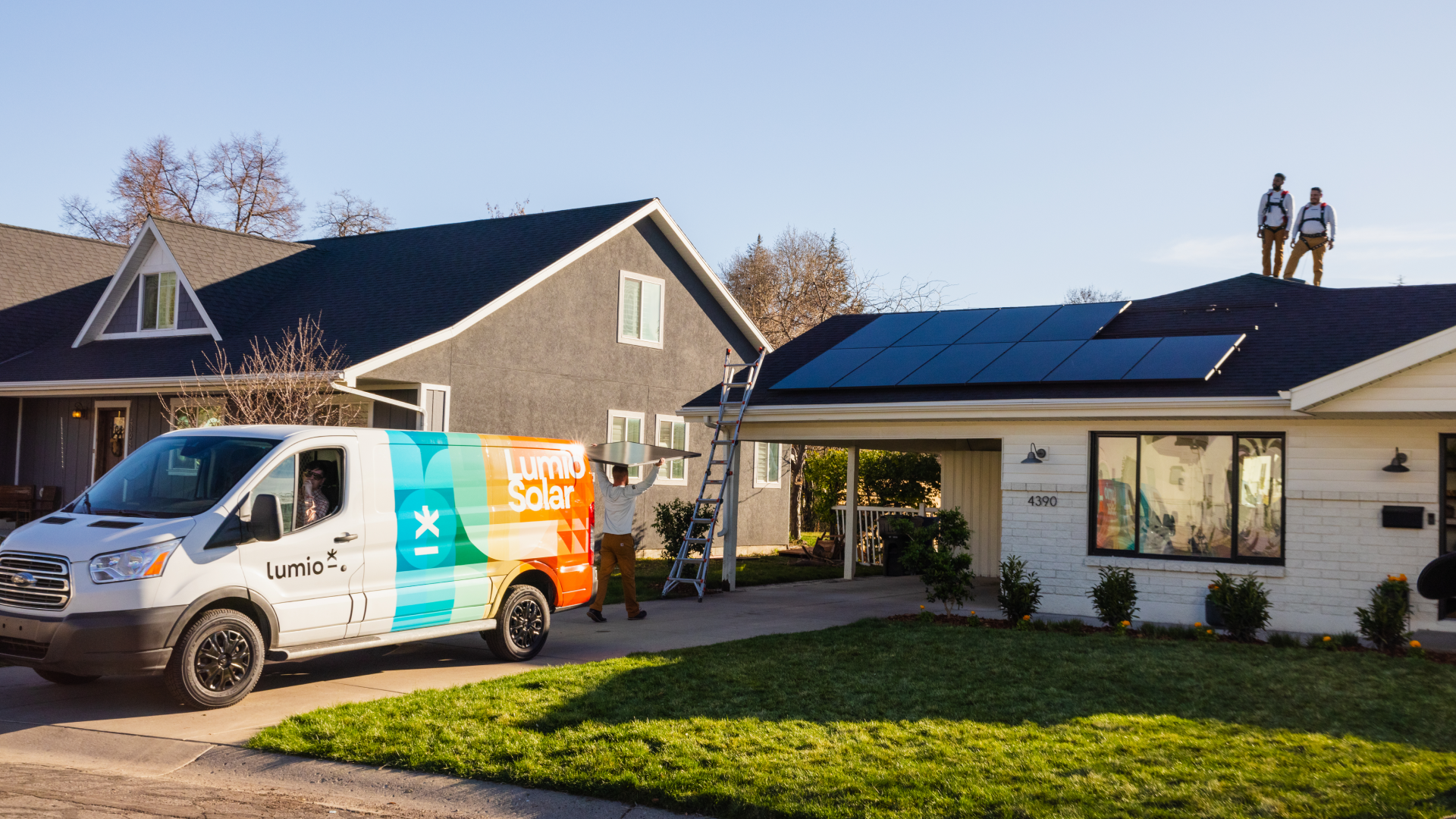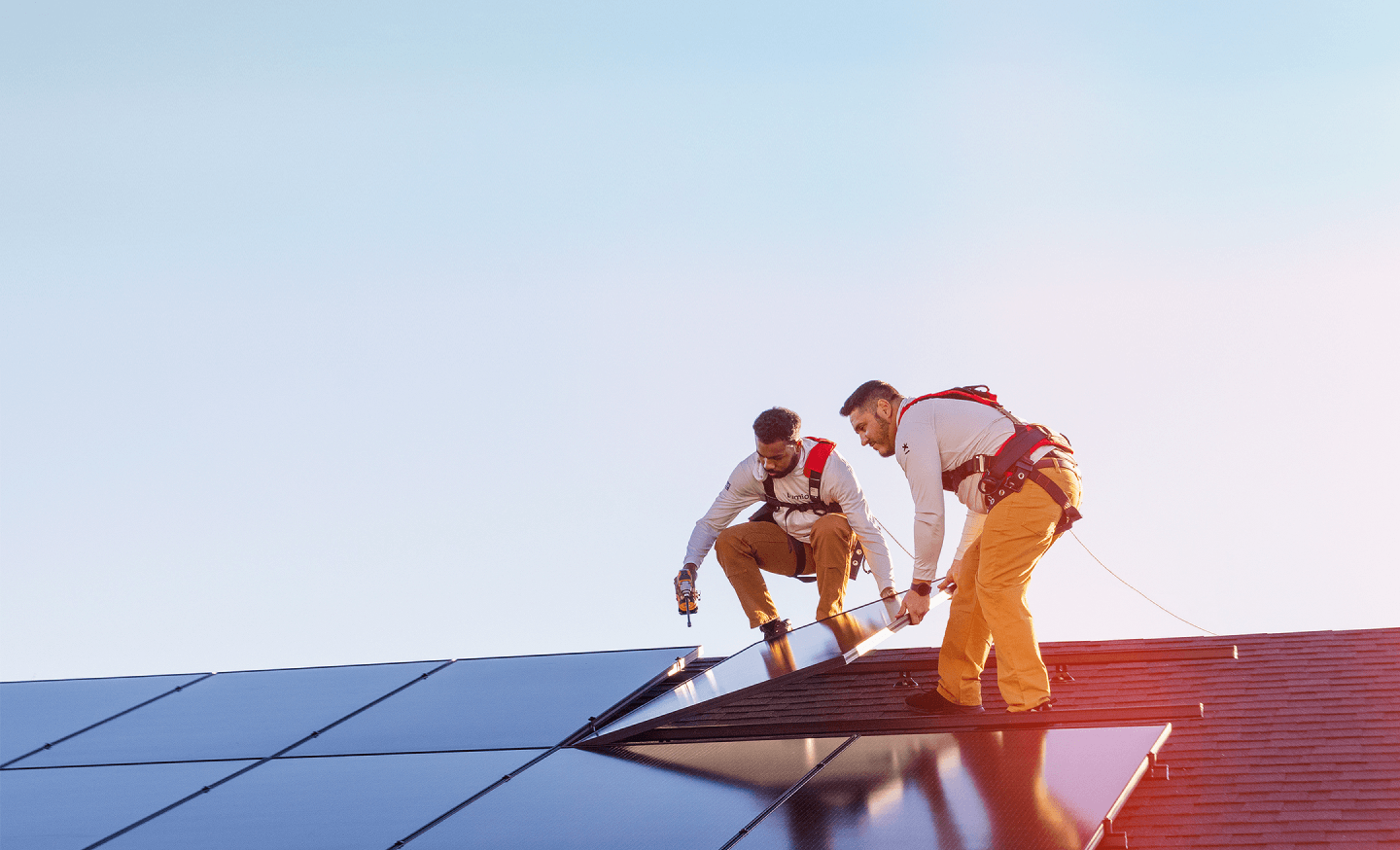Preparing For Installation Day
What happens after your solar permits are approved

by Emily Seare
10 min read - Published on 05/10/2022
What a relief! You’ve successfully completed the solar inspection, design, and permitting processes. Now comes the fun part: scheduling your installation day. The anticipation of what happens on your solar installation day is like waiting for a package delivery to arrive. You notice every car, truck, or van that drives by your house.
The Lumio scheduling team will take the guesswork out of the arrival of the solar installation team. To ensure minimal disruption to your daily life, the scheduling team will contact you to coordinate an installation date that works best for you and we'll keep you in the loop via text message or phone calls throughout the project.
If your schedule is one that is hard to predict, don’t worry. For most homes, we can install the solar roof racks and panels without the homeowner being present. If you would rather be there for the big day, we get it. Most solar installations take around eight hours or less to complete, so it's not a huge time commitment for you, and our team will be working hard to make the whole thing low impact.
Please note: Before work begins on your installation date, we will complete a final inspection to make sure that nothing has changed between our original inspection date and the date of the installation.
Arriving On Site
Installations typically begin in the morning, and our team will arrive at your home in our new Lumio branded vehicle at the scheduled time. You can expect the installation team to be in branded Lumio attire and introduce themselves to you before any work on your home begins.
Please let our installation team know of any preferences you have regarding the care and treatment of your landscaping before they start working. We take pride in providing a clean, considerate, and quick solar installation.
This includes making sure our installation team doesn’t accidentally place a ladder on freshly planted seeds or drop a tool on your prized rose bush.
Staging Area Recommendations
After arriving and introducing themselves to you (if you're home) the Lumio team will need to create a temporary staging site for the installation. It's a good idea for you to choose a good spot beforehand in preparation for install day. A driveway, side yard, or garage will work great as a construction staging area where the team will set all the tools and equipment needed to complete the installation. Ideally, the staging area should be at least as large as an average single-car garage, which is approximately 9 to 10 feet in width and 20 to 24 feet in depth.
Preparing The Staging Space
- Remove any outdoor furniture or decorations that may obstruct the staging area.
- Clear the area of any outdoor toys (e.g., trampolines, swing sets, above-ground pools).
- Discard any trash, yard debris, or animal waste.
- Move all recreational toys and vehicles away from the house to allow the necessary ladders and/or scaffolding to be set up by the installation crew.
- Prune any trees or foliage that may be obstructing your roof.
- Move your roof-top satellite dish temporarily (if needed).
- Park all other vehicles away from the house to create parking space for installation crew members.
- Secure all family pets or livestock.
- Ask the Lumio design or installation scheduling team for any additional changes you may need to make before the installation date arrives.
The idea of the staging area is to limit the disruption to your life and property, and have an organized base of operations for your install project to move along smoothly. As long as it meets the required size we mentioned above, the location of the staging area is totally up to you, so don’t hesitate to let the Lumio installation team know so we can accommodate our set up as needed.

Minimizing Disruptions
While it's safe to be home with your family during installation, it will be a bit noisy, so you might want to make plans to head out of the home on installation day. If you plan to be home during the installation process, it is normal to hear noise from the team installing safety ropes, walking across your roof, placing your solar racking, using their construction tools, and installing your Lumio solar panels. Just be aware it could disrupt that conference call or your little one's nap time.
If you have pets or children who might be bothered by the noise, it's probably smart to plan to hang out at the home of some friends or family. Having vehicles moved from the house also helps our installation team be able to finish their job much faster, because they are able to easily unload tools and access the staging area close to your roof.
Tools Used During Your Solar Installation
Throughout the process, you may notice technicians bringing various materials and tools onto your property. In general, you can expect to see some of the following tools in your home's staging area.
- Digital Multimeter: Because solar panels use a PV system, we need a digital multimeter to test the power quality that comes out of each cell. This tool is also useful for inspecting and maintaining your solar panels in the future.
- Conduit Bender: In order to install a solar system, we need a conduit bender. This bender protects your electrical wiring, so it is an extremely important tool.
- Soladeck: This tool is essentially a junction box. It allows us to run a wire to your roof in a watertight manner.
- Pry Bar: Pry bars are useful for sliding flashing under the roof's shingles.
- Wires: Unsurprisingly, it will take a lot of different wires to connect an entire electrical system.
- Flashing-based Mounts: These are the mounts we use to support your system's rails.
- Caulk Gun: To attach the rails and mounts to your roof, we need to drill holes. For your roof to become watertight again, we have to caulk each hole made to mount the rails with a waterproof sealant.
- Panels: Sleek photovoltaic (conversion of light into electricity) panels that convert the sun’s energy into electrical power.
- Solar Panel Hanger: This tool is used for positioning solar panels on the rails.
- Hack Saw: If we need to cut rails for your roof, a hack saw or a similar kind of saw will be necessary.
- Inverters: We use inverters to convert power from a direct current (DC) to an alternating current (AC) so that your home can use the electricity.
- Wire Stripper: Wire strippers and cutters are necessary for wiring your roof.
- Drill: A battery-operated or corded drill is necessary for installing your panels.
- Screwdrivers: While we do need to use some specialty tools and materials, our team uses good ol' screwdrivers and other standard tools as well.
Nearly all of the tools required for installing your solar panels will be used by the installation team to secure solar racking to your roof.
What Is Solar Racking?
Solar racking is basically another term for a mounting system. It helps to attach your solar panels to the roof. It's a popular way to attach solar systems because it can be used on most types of buildings and roofs.
In general, solar racking costs around $0.10 per watt. If a typical system has 6 kilowatts, then the racking should cost about $600. While it might be fairly inexpensive, this material is incredibly important for your PV system. The cost of your Lumio personal power system includes the expenses required to install solar racking.
Installing Solar Racking
When setting up the racking, the solar technicians will first consider the orientation of your roof. Ideally, the surface of your solar cells will be perpendicular to the rays of the sun. Because this angle changes throughout the year, technicians normally design racking systems that use the same angle as the latitude where your home is located. Additionally, the installation crew will make sure your racking is installed on the side of the roof that has the most sun according to the design and approved plans they'll have in-hand.
The racking system also helps to ensure the best mounting possible. When the solar panels are placed on a roof, they should be parallel to the rooftop. In between the roof and racking, there should be a gap that spans a few inches. On flat roofs, racking allows for the solar panels to be installed at an angle, and therefore capture more sunlight.
Solar Racking Components
There are a variety of different racking systems. While different brands may tweak the overall design, there are a few features you will see in every racking system. In the majority of residential solar systems, you will see the following features.
Mounts
Solar panels have to be attached to your roof using mounts. In a sense, the mounts are like feet. While systems vary, most racking systems use a bolt that connects to your rafters. Because these bolts go through the roof, your solar team will need to access your attic to attach the solar panels.
Flashing
Flashing is used to prevent water from leaking into your home. Because drill holes are frequently used to install solar panels, there is a potential for leaks. Flashing consists of aluminum or other materials that can stop water from entering your home. This material is placed underneath the shingles or roofing tiles.
Rails
Once the mounts and flashing are installed, the installation crew will install the rails. These rails are attached to the mounts, and their job is to hold up your solar panels. While the rails are sometimes made out of different materials, they normally consist of aluminum tracks. These tracks can be installed vertically or horizontally on the roof. Once they are installed, wires can be easily run underneath your solar panels.
Clamps
Clamps are necessary for keeping your racking in place. The installation crew will use clamps to latch the solar modules to the rails underneath them. Mid-clamps are designed to sit between different modules. Meanwhile, end-clamps are big and located at the end of the solar arrays.

Putting It All Together
Step 1: Map It Out
To get started, the installation crew will map out the outline of your roof using your personalized power design. By using the design and roof outline, the installation team will know exactly where all the components of your system need to be placed.
Step 2: Set The Racks
Using the design map, the team will begin setting up your solar racking on your roof. The racking rails will be responsible for supporting the solar panels and positioning them to absorb as much solar power as possible throughout the day.
Step 3: Secure The Mounts
Once the racking is placed, flashing-based mounts will be installed. A mount needs to be placed underneath the flashing every few feet to support the racking rails that will be connected to your solar panels.
Step 4: Get Wired
Once the mounts are prepared, the installation of your solar systems electrical wiring will begin. We will run wires through your home, and these wires will enter the roof using a Soladeck, which is basically a junction box. By using a Soladeck, we can prevent water from leaking into your home.
Step 5: Place The Inverter
From the Soladeck, the wire will go down a conduit until it reaches the inverter. To finish setting up your residential solar system, we will place an inverter on the side of your home and connect the wire to this inverter. This inverter will supply solar energy to your home once everything has been connected properly and the system has been turned on.
Step 6: Secure The Panels
After the solar rack components, wirings, Soladeck, and inverter have been successfully installed, our professional installation crew will begin securing your Lumio solar panels together on the roof, forming the backbone of your solar system.
Learn More
Once everything has been installed, we will clean up the job site removing any tools and equipment used during the installation process. Any items stored in the staging area will also be removed, so that your yard will be back to normal as quickly as possible. Last but not least, the crew will clean up any mess they made while working on your home.
To learn more about the Lumio solar installation process, and get your own customized power plan give one of our solar experts a call today.

